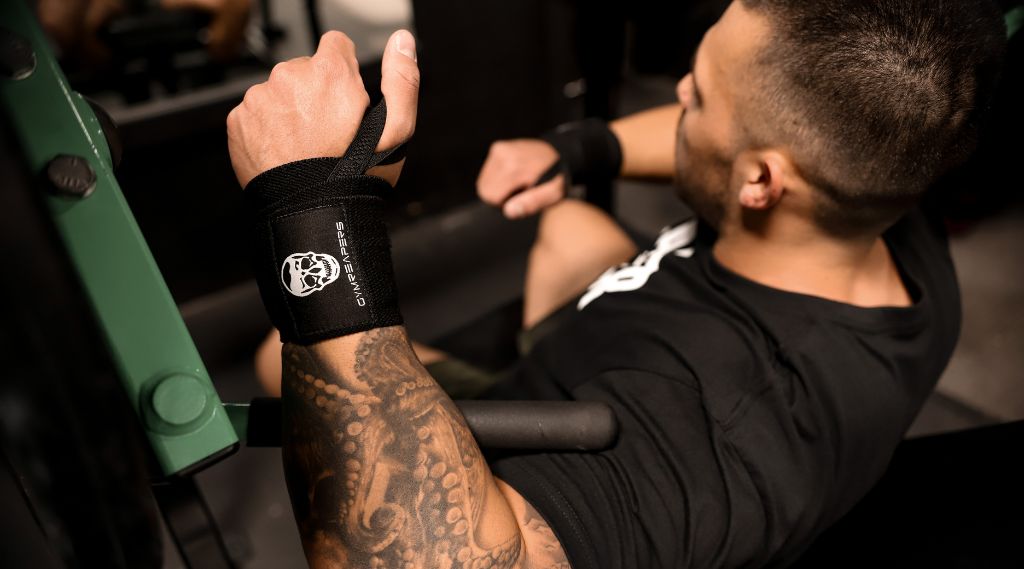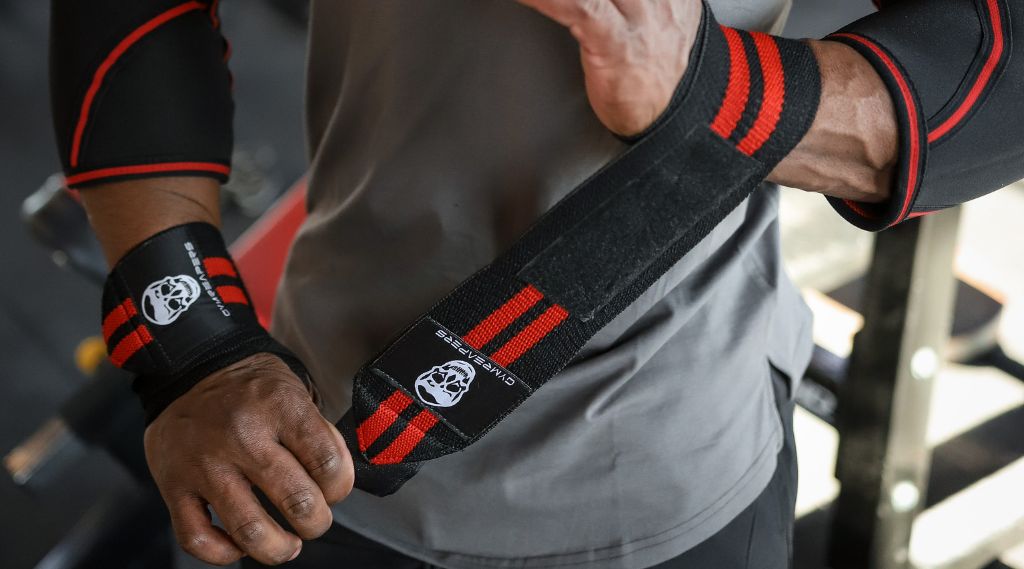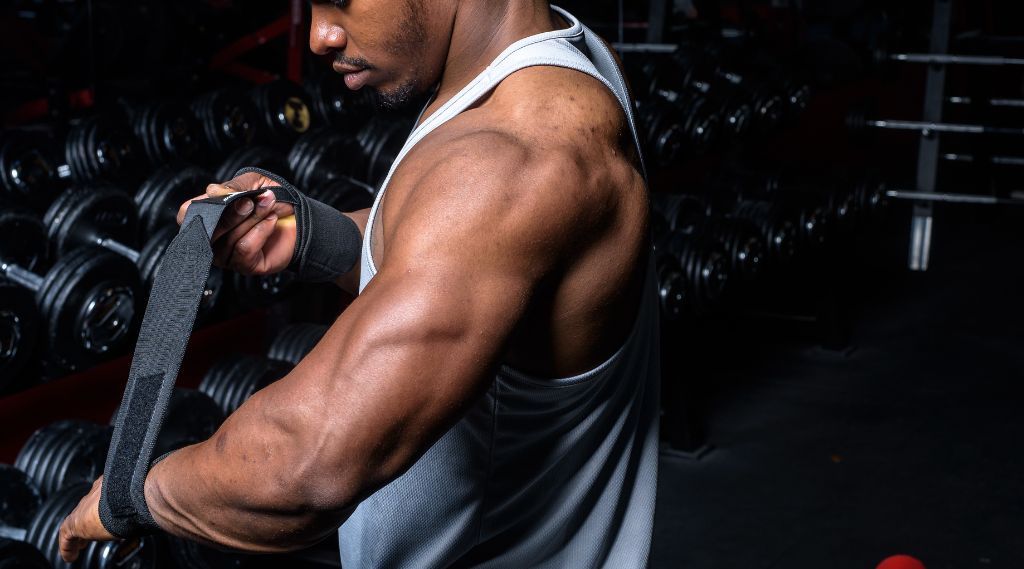When it comes to choosing a set of wrist wraps, people can often be confused about what the thumb loop does and how to properly wear wraps with them attached.
The thumb loop is meant to make your wraps simpler to use by making it easier to start wrapping your wrist. Almost all wrist wraps have a thumb loop attached, and you should use the loop as an anchor point to get the desired position and level of tightness. However, it’s okay if your wrist wraps don’t have thumb loops.
If you’re not taking advantage of the thumb loop because you don’t know how to use it, then you could be missing out on a number of benefits, so I’ll teach you how to wrap your wrist using thumb loops.
Key Takeaways
Why Do Wrist Wraps Have A Thumb Loop?

The thumb loop on wrist wraps is most often used to help adjust the tension when you are beginning to wrap around your wrist. They also just make it easier to wrap your wrist in general by anchoring the beginning of the wrap in place.
Using the loop as an anchor point gives you more control over the tightness and position of your wrist wrap, which are important factors for maximizing the benefits of wrist wraps (which I’ll discuss next).
Being able to anchor the wrap using the loop around your thumb ensures an added level of security that you cannot get when you are just pinching the edge of the wrap in your hands.
The loop removes the risk of you losing your grip at the beginning of the wrap job and also helps you get a much tighter start to the wrap since you can stretch it much further than if you were pinching onto the wrap.
Ultimately, thumb loops exist because they’re more convenient and user-friendly. Wrapping your wrists without thumb loops can be tedious and less effective.
Benefits Of Wrist Wraps With A Thumb Loop
The benefits of wrist wraps with thumb loops are:
Additional Support
The biggest benefit of wearing wrist wraps in general is the wrist support that they provide.
When worn properly, wrist wraps are a great aid in improving your stability and rigidity in your hand, wrist, and forearm area, giving you a much more stable base when you’re lifting.
Since wrist wraps can provide this additional support to essentially “cast” your wrist joint and keep your alignment and form proper, they are a great tool to maximize the amount of weight that you are lifting.
This benefit is backed by research, which states that in addition to providing a more stable base to lift from, wrist wraps can help you generate more power and force when lifting weights due to the reduced energy leak coming from wrist instability and movement.
Thumb loops on wrist wraps just add to these major benefits because you can get a much tighter and more stable start to your wrap when you use them.
Therefore, thumb loops enhance the support that wrist wraps offer by ensuring that you are wearing them properly, which then secures your wrist and reduces energy leaks that come from unwanted instability.
Increased Protection

In addition to added support, wrist wraps can provide greater stability.
This stability of your wrist joint directly decreases your risks of injury, since the wrist wrap can support all the smaller muscles and connective tissues around your wrist joint.
When your wrist is not adequately supported, you are at a higher risk of strains or other injuries due to overextending your wrist muscles.
Adding in a thumb loop gets you that added stability to the wrap job, which will minimize the risk of overextending or overexerting your wrists and keep you healthier.
Alleviate Pain
Another benefit to wrist wraps is their ability to actually alleviate existing pain that normally occurs when you do an exercise without the wraps.
I personally know plenty of people that wrestle with soreness in their wrists when doing certain movements, which can directly limit their ability to lift.
Often, these people find that the compression and stability from wrist wraps alleviates their pain when doing these movements, without aggravating it further, which can be a huge benefit.
Thumb loops give you a great anchor point to really stretch the wrist wrap and create maximum tension and compression to reduce any discomfort you normally experience when lifting without wraps.
While I caution against wrapping your wrists too tightly, the thumb loops are a great tool to help you get the desired level of tightness and the optimal position you need to maximize their benefits.
Do You Need A Wrist Wrap With A Thumb Loop?

You don’t need a wrist wrap with a thumb loop, but it is highly encouraged because of the increased control you have over the position and tightness of the wrap. If you’re unable to wrap your wrist properly, then you’re not maximizing the benefits of wearing wrist wraps.
Who Should Wear Wrist Wraps With A Thumb Loop
Anyone that plans on using wrist wraps should wear wrist wraps with thumb loops because there are no downsides to choosing wrist wraps with thumb loops over wrist wraps without thumb loops.
Choosing wraps with thumb loops can support your wrist, reduce your risk of injury, and alleviate pain, whereas wearing wrist wraps without thumb loops is more like wearing an oversized bracelet if you’re not able to wrap them properly.
Who Shouldn’t Wear Wrist Wraps With A Thumb Loop
The only people who would not benefit from wrist wraps with thumb loops are those who would not benefit from wearing wrist wraps in general, like those who experience discomfort from wearing the wraps, especially if they do not provide any performance benefit and are only causing pinching and irritation.
If you’re experiencing pain, I recommend speaking with a medical professional and confronting the root of your pain so that you can properly strengthen your wrist joints and lift relatively pain-free.
Finally, I would not recommend wrist wraps to someone who does not perform pressing movements (i.e. bench press, shoulder press) or does not lift weights that are considered challenging for them.
How To Wear Wrist Wraps With A Thumb Loop

To maximize the benefits of wrist wraps with thumb loops, it’s important to know how to put them on and how to wear them correctly, so I’ll walk you through the proper technique and discuss the position on the wrist and the level of tightness that you should aim for.
Proper Technique For Putting On Wrist Wraps (Step-by-Step)
- Place the thumb loop around your thumb
- Stretch the wrap tightly across the bottom of your palm and away from your body
- Pull it over the back of your wrist, towards your body
- Imagine tracing an “X” and bring the wrap down across the wrist
- Make sure the wrap is still tight, do not let any slack out
- Continue the X pattern of rotation around your wrist. Do not go higher than your first wrap, and do not go 2 inches below where you would normally wear a watch on your wrist.
- Once you have run out of slack and rotations, fasten the wrap with the Velcro.
- Take the loop off of your thumb.
Position On Your Wrist
As noted in the step-by-step guide, I recommend starting your wrist wrap so that the top edge of the wrap is at the base of your palm. This is an easy position to find when you use the thumb loop.
A good wrap job will cover the base of your palm and where your wrist flexes and extends. Your wrist wrap should not cover your mid-palm or too much of your forearm.
If you wrap it too high, you will not be able to get the loop off of your thumb, and you will have a difficult time grabbing the bar during your lift. If you wrap too low, then you’ll have too much movement in your wrist and not enough stability.
Tightness Of The Wrap
Getting your wrap to the right level of tightness will take some trial and error because it is something that you will have to determine on your own based on how supported you feel and how it affects your ability to press.
That said, there are two main mistakes that people make when tightening their wrist wraps.
The first is that their first rotation around their wrist is too tight. When anchoring your wrap with the thumb loop, make sure that the wrap is taut, but only at about 50-60% tightness. From there, your second revolution should be 75-90% tightness, and your final revolutions should be at 100% tightness.
This progressive tightening technique will maximize the stretch of the elasticity, provide great stability, and will not cut off all blood flow circulation to your hand.
The second mistake is having your wrist in the wrong position when you begin the wrap job.
I recommend starting the wrap job with your hand and your wrist flexing forward. This can easily be done by placing the thumb loop around your thumb, and then flexing your hand forward towards your elbow.
Having the wrist cocked forward like this will make sure that your only wrist mobility will be forward. You will have no unwanted backward flexion or instability in your wrist, which is what normally leads to pain or injury.
When Should You Wear The Thumb Loop?
The thumb loops should only be worn while you’re putting on your wrist wraps; they aren’t meant to be worn the entire time. I don’t recommend wearing the thumb loops while you are lifting.
The first reason for removing the thumb loops is that it can be incredibly uncomfortable. Depending on how tight you wrap your wrists, the thumb loop can actually be pulling your thumb in an unnatural direction, which can be painful and make it harder to grip the bar.
Secondly, it can be quite dangerous to wear the thumb loop when doing a heavy compound movement, which is why many powerlifting federations have rules preventing you from wearing the thumb loops when you step on the platform.
The fabric can very easily get trapped in an awkward position between your skin and the bar. You might not know this has happened until you have unracked the bar and are completely supporting its weight.
In circumstances like this, your best-case scenario is the fabric biting into your skin and being deeply uncomfortable. But in a worst-case scenario, this barrier between you and the bar can hurt your grip and cause you to drop the bar on yourself or your spotters.
How To Choose The Right Wrist Wraps With A Thumb Loop

There are many different types of wrist wraps with thumb loops to choose from so it’s important to understand what to look for in a high-quality wrist wrap.
Material
The first consideration you should look at when choosing the right wrist wrap with a thumb loop is the type of material it is made out of.
At their core, every wrist wrap is a long piece of elastic, or some other blend of a stretchy type of fabric, that you can wrap around your wrists to prevent them from bending when using heavy loads.
However, there are some different types of materials with different benefits that you can choose from. Depending on your fitness goals, there are two main types of materials that you’ll find with wrist wraps:
Flexible: these wrist wraps tend to be thinner, more comfortable, and stretchier. They are easier to stretch and wrap around your wrist, are more breathable, and are easier to air out.
A great example of a flexible wrist wrap with a thumb loop is the Gymreapers Weightlifting Support Wrist Wrap. This wrist wrap is made from an elastic and polyester blend, is competition approved, and is ideal for anyone who enjoys powerlifting, Olympic lifting, CrossFit, or general weight training.
Stiff: these wrist wraps are usually tougher, less flexible, and are supported by cross-stitching and multiple layers of nylon. You may also see these wrist wraps made out of some type of elastic and polyester blend.
These are more frequently used by strongman and powerlifting athletes, as they are more durable and helpful when lifting very large amounts of weight.
A great example of a stiff wrist wrap with a thumb loop is the Gypreapers Stiff Wrist Wraps - Heavy Duty Wrist Support. These wraps are incredibly rigid, reinforced for longevity, and designed to support athletes lifting heavy loads.
Length
Most brands of wrist wraps come with the ability to choose different lengths.
Most commonly, lengths come in 3 main categories:
- Shorter wraps: 12-18 inches
- Medium wraps: 18-24 inches
- Longer wraps: 24+ inches.
Based on your sport and the type of lifting you do, you may want a different length of wrist wrap.
Wraps in the shorter category are best for more general lifters and bodybuilders, or for smaller individuals. They provide less support, since they give fewer overall revolutions around your wrist, but are still helpful for these people.
Medium-length wraps are the most common choice for most people. They provide a nice blend of support and comfort and are most widely available across brands.
Longer wrist wraps are primarily used for people who have very large wrists and forearms and/or people who are lifting incredibly heavy weights. They provide the maximum support, but they are pretty cumbersome and are overkill for most athletes.
Note that the Gymreapers Stiff Wrist Wraps provide you the option to choose your preferred length with choices that range from 12, 18, 24, and 36 inches.
On the flip side, the Gympreapers Flexible Wraps come solely in the 18-inch category, which is most commonly preferred by the majority of people.
Other Considerations: Durability And Warranty
Some final considerations that you need to think about when buying wrist wraps with thumb loops are their durability, and level of warranty.
The most common problem with a wrist wrap actually stems from the thumb loop. Since this is the anchor point against which most people pull their wraps tight to begin the wrap job, it is also the first part of a wrap that can break down and tear.
When buying a wrist wrap with a thumb loop, you should look for reinforced stitching and high-quality materials so that you can count on adequate longevity.
As an example, look to the Gymreapers Stiff Wrist Wraps for heavy-duty wrist support. These wraps boast premium quality since they are made from reinforced material and have an even thicker than normal thumb loop that is outlined with durable stitching specifically designed to prevent tears.
While these details and features are a nice touch and likely mean you will have no troubles with longevity, you should still look for products that come with a warranty.
An example of a great warranty policy can be found on those Gymreapers stiff wraps, where they offer a lifetime replacement guarantee with no added cost.
FAQ:
How Do Thumb Loops Help?
Thumb loops make it easier to start wrapping your wrist by providing an anchoring point for the first rotation of the wrap around your wrist. Using thumb loops will help you find the perfect tightness and will reduce the risk of your wrap slipping.
Are Thumb Loops Allowed In Powerlifting?
You may use thumb loops in powerlifting to tighten and secure your wrist wraps, but the rules prohibit you from wearing the loop around your thumb while lifting. If you do this, your lift will not count.
How Do You Wear Wrist Wraps Correctly?
To wear wrist wraps correctly, you should start by using the thumb loop and begin the wrap at the base of your thumb on the lower part of your palm. Each rotation around your wrist should get progressively tighter, providing enough support and stability to keep your wrist in place under heavy loads.
How Tight Should Your Wrist Wrap Be?
Wrist wraps should be tight enough to provide a cast-like effect where your wrist is stable and supported so that it will not involuntarily bend backward. However, your wrist wraps should be loose enough that they are relatively comfortable and are not cutting off circulation in your wrist.













Leave a comment
All comments are moderated before being published.
This site is protected by hCaptcha and the hCaptcha Privacy Policy and Terms of Service apply.